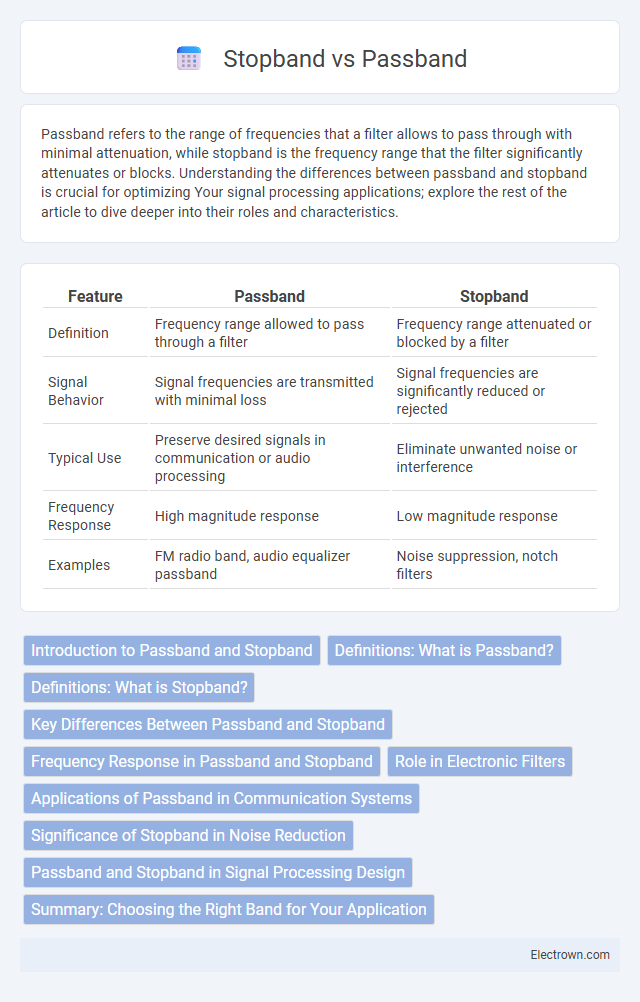Passband refers to the range of frequencies that a filter allows to pass through with minimal attenuation, while stopband is the frequency range that the filter significantly attenuates or blocks. Understanding the differences between passband and stopband is crucial for optimizing Your signal processing applications; explore the rest of the article to dive deeper into their roles and characteristics.
Table of Comparison
| Feature | Passband | Stopband |
|---|---|---|
| Definition | Frequency range allowed to pass through a filter | Frequency range attenuated or blocked by a filter |
| Signal Behavior | Signal frequencies are transmitted with minimal loss | Signal frequencies are significantly reduced or rejected |
| Typical Use | Preserve desired signals in communication or audio processing | Eliminate unwanted noise or interference |
| Frequency Response | High magnitude response | Low magnitude response |
| Examples | FM radio band, audio equalizer passband | Noise suppression, notch filters |
Introduction to Passband and Stopband
Passband refers to the range of frequencies that a filter allows to pass through with minimal attenuation, ensuring signal integrity within this spectrum. Stopband is the frequency range where the filter significantly attenuates signals, effectively blocking unwanted frequencies. Understanding passband and stopband characteristics is crucial for designing filters in communications, audio processing, and signal control applications.
Definitions: What is Passband?
The passband is the range of frequencies that a filter allows to pass through with minimal attenuation, ensuring signals within this band remain strong and clear. It is defined by the lower and upper cutoff frequencies where the filter begins to reduce signal strength, separating the passband from the stopband. Understanding the passband helps you optimize signal processing by maintaining desired frequencies while excluding unwanted noise.
Definitions: What is Stopband?
Stopband refers to the range of frequencies in a filter where signal attenuation is significantly high, effectively blocking or eliminating unwanted frequency components. In filter design, the stopband is critical for preventing interference by reducing the amplitude of frequencies outside the desired passband. Understanding the stopband helps you optimize signal processing systems by ensuring that only intended frequencies pass through while undesired signals are suppressed.
Key Differences Between Passband and Stopband
Passband refers to the range of frequencies that a filter allows to pass through with minimal attenuation, typically characterized by a flat response and low signal loss. Stopband denotes the range of frequencies that a filter significantly attenuates or rejects, often marked by high attenuation levels to prevent unwanted signals from passing. The key differences between passband and stopband lie in their frequency ranges, signal attenuation levels, and their roles in frequency filtering applications.
Frequency Response in Passband and Stopband
Passband frequency response defines the range where Your signal passes through with minimal attenuation, maintaining consistent amplitude and phase characteristics for optimal transmission. In contrast, the stopband frequency response exhibits significant attenuation, effectively blocking unwanted frequencies to prevent interference and signal degradation. Precise control over the transition between passband and stopband is critical for ensuring filter performance meets design specifications.
Role in Electronic Filters
Passband and stopband are critical frequency ranges that define the functionality of electronic filters by determining which signals are allowed to pass and which are attenuated. The passband allows frequencies within a specific range to pass through with minimal attenuation, maintaining signal integrity for your desired applications. Conversely, the stopband significantly reduces unwanted frequencies, ensuring noise and interference are effectively filtered out to improve overall circuit performance.
Applications of Passband in Communication Systems
Passband filters are crucial in communication systems for isolating desired frequency ranges while rejecting unwanted signals, ensuring clear signal transmission and reception. They enable multiplexer designs and frequency division multiplexing by allowing multiple channels to coexist without interference, optimizing bandwidth utilization. Your communication devices rely on passband filters to maintain signal integrity, minimize noise, and enhance data quality across wireless, radio, and optical communication applications.
Significance of Stopband in Noise Reduction
The stopband in a filter is crucial for noise reduction as it blocks unwanted frequencies that could interfere with the desired signal, enhancing overall signal clarity. By attenuating these frequencies, the stopband minimizes the impact of noise and prevents distortion in your audio or communication systems. The effective design of stopbands directly influences the quality and reliability of signal processing applications.
Passband and Stopband in Signal Processing Design
Passband and stopband are critical concepts in signal processing design that define frequency ranges for filters. The passband allows signals within a specified frequency range to pass with minimal attenuation, ensuring signal integrity for desired frequencies. Conversely, the stopband significantly attenuates frequencies outside the passband, preventing unwanted signals and noise from interfering with the system's performance.
Summary: Choosing the Right Band for Your Application
Passband refers to the range of frequencies a filter allows to pass with minimal attenuation, while stopband denotes frequencies significantly attenuated or blocked. Selecting the right band depends on application needs such as signal clarity, noise reduction, and system performance requirements. For communication systems, prioritizing a wider passband ensures data integrity, whereas in noise-sensitive environments, a well-defined stopband enhances signal quality by filtering out unwanted frequencies.
passband vs stopband Infographic

 electrown.com
electrown.com